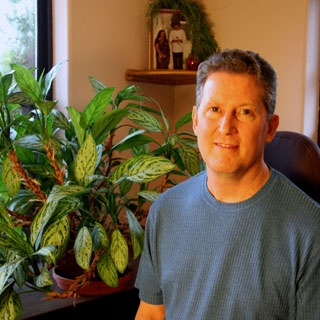“The tensions that I experienced of years ago, especially from about the time we tried to incorporate, are no longer. I don’t feel anything like that from people, and there’s much more of a mature respect I think about what everybody’s points of view are. We all have to live together and get along.”
–Joseph Selbie
An Excerpt from the Interview
Joseph Selbie: I moved to Ananda in 1975. I was the manager of the meditation retreat from 1978 to 1980. I spent a couple of years in Italy helping get a yoga center established in Rome. I was the community manager of Ananda Village until about ’85 and then I went up to Seattle, helped get another community started in Seattle from ’85 to about ’91. So , as you can see, while Ananda Village has been home base, I’ve been around and about quite a bit.
NCSCC: And is there a dedicated group of people that you’re working with? Or are you often working with different folks out of the Ananda network?
Joseph Selbie: It’s been fairly fluid. As I just described, my personal experience has been a succession of different positions within Ananda — up to the point where having the responsibilities of raising four children kind of priced me out of the Ananda business market. I couldn’t afford to raise a family of four on Ananda’s low wages so in 1995 I cofounded Tristream which is a web development company. My oldest daughter, Michelle Cowie, whom many people who live on the Ridge know, was our first employee. She still works for Tristream on a consulting basis.
Even with Tristream as my main focus though, I still do a lot of volunteer activities within the community.
Recently I’ve become an author. I’ve written a book about the yugas, the concept of a historical 24,000 year cycle, called simply “The Yugas.” A lot of my background in college was in ancient history and archaeology, and I was fascinated from the time I was in grade school about the truly ancient past. I remember vividly being in sixth grade and being told that we were going to get to study ancient civilizations. I was so excited. “Oh, this is going to be interesting!” And then they spent one week on the Greeks and the Romans and that was it. I was so disappointed — and remained convinced there was a lot more to ancient history and prehistory than that!
In 1974 I was introduced to the idea of the yugas. It’s an Indian tradition, it comes out of the Vedas, but it’s also very specific to the teachings of Yogananda because his teacher, Sri Yukteswar, wrote an exposition on the yugas. So I took that core material and worked with another man at Ananda who’s been researching the subject for years and years, and we put together a book to show that there is a clear historical footprint of the yugas. You can see a 24,000 year cycle footprint in history if you look at it through the lens of changing consciousness rather than changing technology.
One thing I learned during the project is that I enjoy writing immensely.
Out of that project I became inspired to write what I call a spiritual fantasy: “Protectors Diaries: The Fifth Force.” It’s a book about a fictional group of “Protectors” who are essentially realized beings, but they’ve been asked to stay on the earth and prevent really egregious things from happening to mankind. They have powers as you would imagine based on their being realized. They live for very long periods of time or reincarnate once again knowing who they were in the last incarnation. I’m working on the second novel in the series right now.
NCSCC: So it’s almost like they’re superheroes?
Joseph Selbie: They’re almost like superheroes, but they’re not — they’re not really attached to the world — they have that otherworldly consciousness of a saint, or a realized master, or a Zen master, or whatever path you can understand it from, where they’re detached yet they’re serving. And they also don’t want to be known at all, so everything they do is as hidden as possible. Think of it as “Mission: Impossible” meets “Autobiography of a Yogi.”
•
Joseph Selbie: Ananda is by no means alone nor the first in the development of intentional communities. Many of them are spiritual. You have the Amish and the Mennonites and the list goes on and on. The earlier spiritual communities, if you will, were the monasteries and convents in Europe. And so the spiritual focus is a natural way that the members of a community are tied together. But there are many communities that have alternate focuses that are not overtly spiritual or not focused on a single spiritual path. Whatever the focus, it needs to be compelling, certainly in the starting phase. Starting a community requires self sacrifice. If there isn’t a deeply meaningful ideal that is drawing you into it before long you’re going to say, “This just isn’t worth it!” It takes a lot of time and effort and personal giving to make a community work.
I believe communities of all kinds are a natural pattern that’s going to become more prevalent in the world. Because I live in a community, I tend to know a lot about other communities and communicate with other communities around the world. Ananda has hosted seminars on how we did it and has hosted visiting groups from other communities to learn how they did it. These kind of interactions have given us a sense of the growth of the communities movement. And it’s pretty significant. There are thousands of communities worldwide. You don’t hear much about them because they’re kind of inherently quiet. They’re not evangelical. They’re not trying to reform the world through a political process. They’re just going out and doing it.

